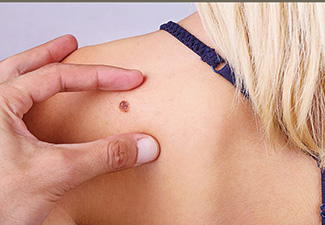 Summer sun, whether working or having fun, also can mean danger in developing skin cancer, the most severe of which is melanoma.
Summer sun, whether working or having fun, also can mean danger in developing skin cancer, the most severe of which is melanoma.
Melanoma is less common than some other types of skin cancer, but it is more likely to grow and spread. Once a doctor identifies melanoma, the next, critical step is staging it or determining its severity.
After someone is diagnosed with melanoma, doctors will try to figure out if it has spread, and if so, how far. This process is called staging. The stage of a cancer describes how much cancer is in the body. It helps determine how serious the cancer is and how best to treat it. Doctors also use a cancer’s stage when talking about survival statistics.
According to the American Cancer Society, the earliest stage melanomas are stage 0 (melanoma in situ), and then range from stages I (1) through IV (4). Some stages are split further, using capital letters (A, B, etc.). As a rule, the lower the number, the less the cancer has spread. A higher number, such as stage IV, means cancer has spread more. And within a stage, an earlier letter means a lower stage. Although each person’s cancer experience is unique, cancers with similar stages tend to have a similar outlook and are often treated in much the same way.
Doctors rely on a variety of methods and tools to accomplish this. These generally include biopsy (removing skin, lymph-node samples, or other tissues and sending them to a pathology lab to be examined under a microscope); or, for more advanced cancers, imaging tests such as CT, MRI or PET scans.
Accurate staging is vital for determining the best course of treatment. Early-stage melanomas can often be treated with surgery alone, but more advanced cancers often require other treatments. Sometimes more than one type of treatment is used.
LOWER YOUR RISK
There is no sure way to prevent melanoma. Some risk factors such as your age, race, and family history can’t be controlled. But there are things you can do that could lower your risk of getting melanoma and other skin cancers.
• Limit your exposure to ultraviolet (UV) rays
The most important way to lower your risk of melanoma is to protect yourself from exposure to UV rays. Practice sun safety when you are outdoors.
• Seek shade
Simply staying in the shade is one of the best ways to limit your UV exposure.
• “Slip! Slop! Slap!… and Wrap”
If you are going to be in the sun, this catchphrase can help you remember some of the key steps you can take to protect yourself from UV rays: Slip on a shirt. Slop on sunscreen. Slap on a hat. Wrap on sunglasses to protect the eyes and sensitive skin around them.
• Avoid using tanning beds and sunlamps
Many people believe the UV rays of tanning beds are harmless. This is not true. Tanning lamps give off UV rays, which can cause long-term skin damage and can contribute to skin cancer. Tanning bed use has been linked with an increased risk of melanoma, especially if it is started before a person is 30. Most dermatologists (skin doctors) and health organizations recommend not using tanning beds and sun lamps.
• Protect children from the sun
Children need special attention, since they tend to spend more time outdoors and can burn more easily. Parents and other caregivers should protect children from excess sun exposure by using the steps above. Children need to be taught about the dangers of too much sun exposure as they become more independent.
• Watch for abnormal moles
Some melanomas develop from moles, but most do not. Checking your skin regularly may help you spot any new or abnormal moles or other growths and show them to your doctor before they even have a chance to turn into skin cancer. Certain types of moles are more likely to develop into melanoma. If you have many moles, getting careful, routine exams by a dermatologist, along with doing monthly skin self-exams are, might be recommended.


